Guest Contribution by Tim Prebble

I suspect growing up in a very quiet location on a farm in the South Island of New Zealand may have something to do with it, but I feel I have always been very aware of ambient sound. I have vivid sound memories from childhood, of ambiences! Waking up before the birds and waiting for them… The sound of the wind in blue gum trees and the sound from inside the shed when a bluegum nut fell off the tree and landed on the tin roof & rolled down… The sound of the Rangitata river when it was in flood and that time my dog swam out to an island & got stuck there for a while… what was he thinking?? Whether being sound obsessed is 100% normal I’m not sure, nor do I care, but when I first started working as a trainnee sound effects editor recording and editing ambiences was one of the first things I really relished. And decades later I still do. The contribution ambiences make to a film is so powerful, and yet they achieve their effect via the most understated duplicitous act: ideally an audience doesn’t notice them, but is deeply effected by them.
Over the years I’ve documented many of my experiences recording and editing ambiences for films and while I won’t repeat those here, I will compile a little directory at the end of this article to help anyone interested to revisit them, as they can otherwise get lost in the digital equivalent of a dusty old archive. 2012 has presented a number of new challenges for me with respect to ambiences and I thought I’d share what I’ve learned in the process, in particular recording ambiences in remote locations and in a few cases in dangerous situations. But first I’d like to state why I so highly value recording ambiences for projects I work on, as I’ve learned its important not to take anything for granted especially when its the context of something so particular as your motives; why is as as important as how!
Practicality, Memory & Authenticity
Whenever I first read a script most of my brain is constantly aiming to stay in the moment – to experience the script as a film – but every so often a little part of my right brain pipes up & thinks: oh! Thats a sound we don’t have – that will need recording! So when I read a script where that applies to every location, a sense of excitement starts to build as I imagine what will be involved in creating the resources we will inevitably need to fully realize the project. When the film is set in your own country the scale of such things is far reduced – I love travel, it broadens the mind as the saying goes, but I especially love sonic travel and to be clear there are three very important motives which I have come to believe make it an intrinsic part of what I do.
First is practicality. As an example the first time I read the script for Taika Waititis film BOY, I thought I’d love to go and revisit the East Cape where the film is set, as it is such a beautiful part of the country & remote enough not to be spoilt by too much development. But when I reached the first scene in the script that is set in a paddock of 8 foot tall corn I realized I HAD to go! And that there was a deadline, since by the time the film is in post that corn will be on peoples dinner tables! Now of course the production sound recordist will do his best to grab some wildtracks for us, and he did. But you only have to visit a film set for five minutes to appreciate how demanding the role of production sound is, and how clear their priorities are. Actors, performance and emotion… rustling paddocks of corn, less so. Accordingly three or four months before we started work on the film I managed to take some time off and went for a holiday to the East Cape and I recorded that corn paddock, multi channel! But that leads me to the second critical attribute: memory.
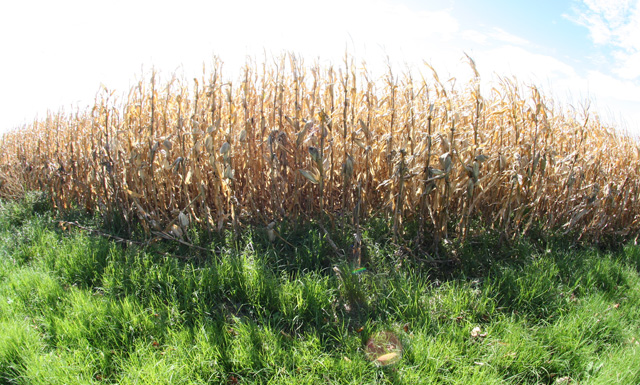
Looking at that photo, can you imagine the sound of the wind as it travels across that paddock? It was literally like an ocean of rustles…. While I was in East Cape I recorded ambiences in twenty or more locations, and every one of those places is etched in my memory as clear as a bell. I remember how for the river scene I visited the bridge location and recorded, but it was only so interesting, so I went for a walk downstream and recorded rapids, then some wide perspectives (good for the surrounds I noted) and then found a huge area of toitoi bushes that had the most exquisite rustle. I can see and hear each of these locations like it was yesterday. Except it wasn’t yesterday, it was April 2009. And when I dive into SoundMiner years later and come across one of those ambiences, my eyes glaze over and I am back there for a moment. I place great value on the memory of each location, for the conscious memories are important but so also is the subconscious; travelling many hours to a location just to sit still, listen, record and remember – those subconscious memories are what feed your instincts. So when it came to editing ambiences for the film at the time, it was such a pleasure to assemble the recordings from each actual location and use them as the core. Comparatively the opposite can sometimes seem like a false economy – it can be so frustrating to spend hours trawling through hundreds of not-quite-the-right sounds in the library, searching without a reference. And funnily enough that reference has a name: authenticity.

We’ve all heard it: the loon in the wrong location/country. The hawk screech in a place where there simply are no hawks. While such errors are almost comedic, and maybe for some/most audiences irrelevant, where the source of problem lies is in the motive: does it matter? If you find yourself asking ‘can we get away with it?’ the answer is likely no and the question should have been asked months prior and actions set into motion. Last year I had the great pleasure of working on THE ORATOR by Tusi Tamasese which is set and filmed in Western Samoa. Now you don’t have to be a rocket scientist to realize Samoa is not going to sound like New Zealand, so very early on in proceedings (ie before budgets are locked down) I stated the obvious: I need to go to Samoa to record ambiences. And the answer? Both the producer and director had already had many discussions and it was already budgeted for! Because they had been there – Tusi is Samoan & grew up there – and knew how important the ambient sound world was to the film. At this point I had a revelation: recording ambiences on location is not a budget issue, its an issue about priorities. And understanding. The budget for THE ORATOR would be considered an indie film budget in Hollywood, and yet I hear people working on US$100million films saying there is no budget to record ambiences on location! What they really mean is someone does not understand why it is important enough to prioritise it. And when that is the case, the best way to make people learn is to do it anyway: fund it yourself, and then quietly make them VERY AWARE of what you did and why. Not to be a smart ass, but to set in motion a modus operandi. When I work on your film I visit locations. End of story.
Recording in Samoa taught me many things that have informed every project I have worked on since. It was my first time traveling across borders with a serious amount of equipment and it was also nearing the end of the rainy season so we could still expect the occasional torrential downpour, and in fact needed some for two critical scenes in the film. So that required some very strategic thinking about protecting gear. Some of the locations I stayed at would not have power so being prepared with enough batteries was crucial. But as I invested in batteries I came to a decision: I was going to do an overnight record session. The film is mostly set in a remote village in Samoa which I stayed in for a couple of days, so I took enough batteries to record from late afternoon, through dusk, through night and right through to dawn. If you ever recorded night insects for five or ten minutes and thought you’ve got a long ambience track, try seven hours of night insects!! It was an interesting prospect – painful at the time as I had to estimate how long my batteries would last and set an alarm to wake up to check and swap batteries. But later in the studio it was truly amazing, contrasting the changes by jumping forwards an hour or two in the timeline. It showed just how much the ambience of night evolved…
I know I’m stating the obvious but for the director, the life of their film is very important. Its success in the world is critical to their future as a film maker. But showing the film to its home crowd is also very, very important. And providing authentic ambiences to the mix made me feel confident that when a Samoan audience see and hear this film they will believe it. There are no loons in Samoa.
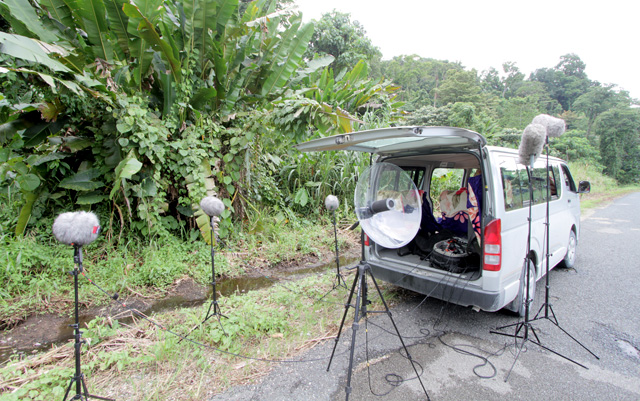
And so twice this year I had similarly rewarding experiences while working on EMPEROR by Peter Webber which is set in Japan 1945 and MISTER PIP by Andrew Adamson which is set & filmed in Bougainville, Papua New Guinea . When I pitched for each film I discussed with the director and producer how important it was to visit locations to record ambiences, and how we would need to budget for it. How many of my recordings from locations are in the soundtracks for those two films? All of them! Samoa was a comparatively safe destination, whereas everyone I spoke to seemed to have a story about Papua New Guinea. For a start it required medical preparation – maleria is an issue so prescriptions are required which means starting to take meds ten days before arriving and a month afterwards – maleria can live in you for weeks after exposure without presenting… And some maleria meds have a side effect of making people go psychotic! Great! That would make for some interesting ambience recording!! Just getting to the locations was a mission – three flights, a short boat trip, then a five hour trip in a 4WD down a spine rattling dirt road with five river crossings, one of which delayed us for a few hours as the river was in flood and was unsafe to cross. When we did eventually cross it, the driver got half a dozen or so bystanders to climb on the 4WD, for added weight. I took it as a sign of faith – they wouldn’t get on if we weren’t going to make it, but crammed in the back of a 4WD full of gear I did eye up which pelican case I was going to grab if we did get overturned in the river!
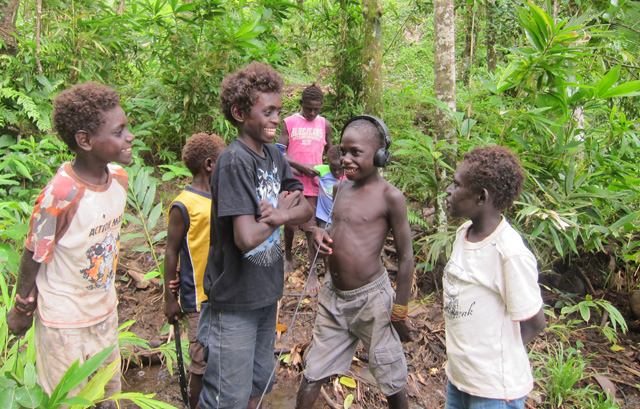
In Papua New Guinea humidity was a real issue – for the gear and for me. The first ambience I went to record, two of my six mics didn’t work! It was so hot & humid I was sweating like crazy and we were on a trek into bush and had arrived at a small river crossing. I set up to record the river and was getting no signal from one microphone and just splats from another… Switch cables to eliminate them, nope. Switch inputs on my mic preamp and the splats are gone – I theorized humidity moisture had got into the phantom power and after ten minutes of messing around the dead mic came back to life and I never had another problem with it…. I learned how important it is to let microphones acclimatize; every time you use them, not just when you change countries.
Everywhere I went in Papua New Guinea I had the gang of kids in the photo above helping me – they were great & I made sure they got paid, but their confidence in the environment was also a little misleading. In my research I had read about every dangerous insect and animal in PNG and was prepared to be super vigilant, wearing sturdy shoes etc… But then I noticed these kids were barefoot! I didn’t follow suit, but it made me aware not to assume anything. Another example: at that river where my mic died, the kids crossed the river by just stepping from rock to rock. I smiled when they waved at me to follow their path, as I was well aware I was carrying two recorders, a preamp, six microphones and those rocks were slippery. I wasn’t about to put the entire trip & myself in jeopardy by pretending to be fleet footed… In I waded, the river got up to waste height, but the current wasn’t strong and every footstep I took I made sure I was secure before lifting my other foot. So these are things you might not worry about, sitting in your air conditioned studio but theories are only worth anything if they can be applied in practice and reality can be a brutal teacher if you aren’t prepared!
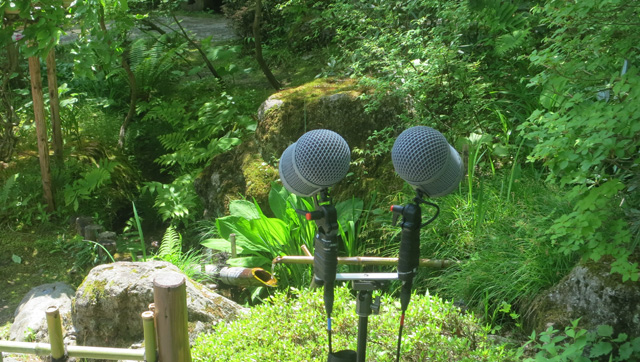
Japan was a pleasure to travel in, but frustrating at times due to the time period of the film I was working on. Japan in 2012 is full of sounds inappropriate for 1945 and accordingly I did a lot of driving to rural areas and simply would not have achieved half of what I did without google maps on my iPad and the car navi. As is always the case with travel, my experience was multiplied exponentially by knowing and meeting great local people who helped me. In hindsight it all seems well planned but such trips are as much about adapting to situations and improvising, as they are about research and planning. Often we arrived at a place that looked perfect but was sonically ruined by one or two elements, like the perfect bamboo forest which a school class had just arrived at for the day! But if it was easy anyone could do it and again as with travel it is what you discover along the way that really matters.
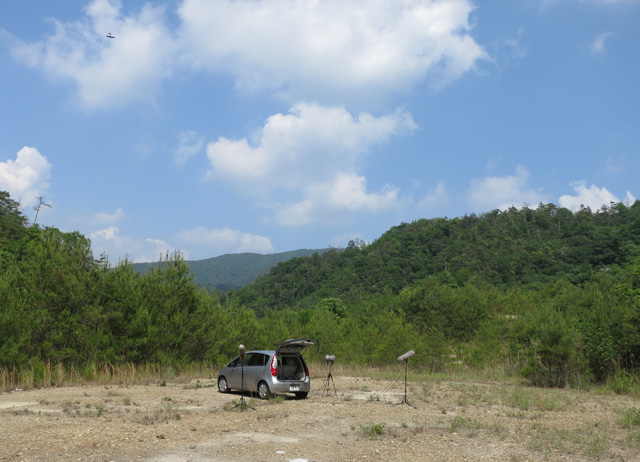
If you have sharp eyes you’ll notice something in that photo (taken inland from Onomichi) which is not a bird – WTF is a model airplane doing in the middle of nowhere?? Please see this post
So each of the situations described thus far have had potential dangers but the one location that prompted writing this article was a recording I did earlier this year at Aratiatia Rapids. I think I know New Zealand fairly well, having travelled from one to the other but I had never visited Aratiatia Rapids before, even though it is on the main route north. Basically it is a huge rocky river which is completely dry due to diversion for power generation, and I am not sure whether it was due to the resource consent or just for tourism, but four times a day they open a flood gate and let the river revert to its natural state for half an hour. A friend had mentioned it to me and as I was heading to Auckland to record vehicles for EMPEROR I decided to go record it. I got packed up & left Wellington early and arrived in Taupo by midday, drove to the location only to discover it was raining! I waited, hoping the rain might stop in time, but it didn’t – I could record in this siutation but I could do a recce! So I put a coat on and went for a walk and as it turned out doing this was a blessing indisguise. Had I turned up & recorded it without doing a recce I would simply not have got very good results. Standing by the flood gates was hopeless for recording, even in the rain there was half a dozen tourists milling around with cars coming and going, but I noticed a walking track & set off fifteen minutes down stream to a viewing area on a rock outcrop directly over the rivers path, and OMFG the perspective was scary. This is a part of the same river which exits Lake Taupo and goes through Huka Falls at 220,000 litres per second! So my recce taught me two things: I had worked out where to put my mics, but that location was dangerous! Even hanging a mic off the side of railing was to put it in jeopardy, as there was no way to safely retrieve it! I left there and headed north, thinking about how to solve these problems as I would be returning via the same route & would get another opportunity.
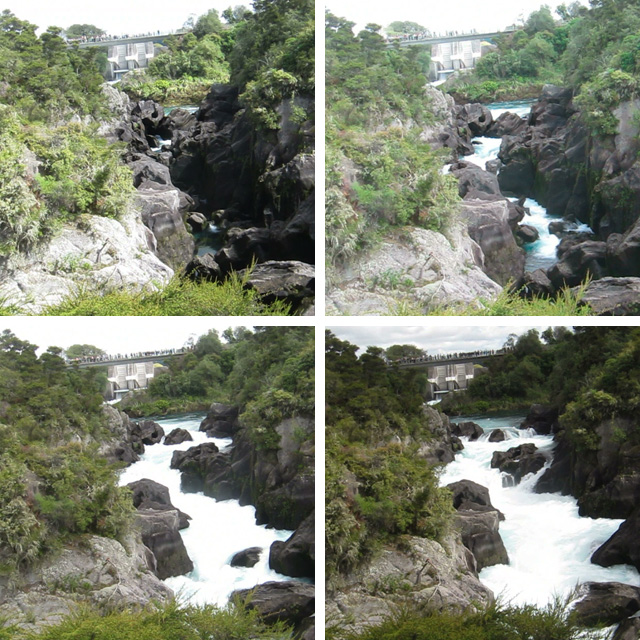
When I returned a week later, the weather had cleared and from my recce I knew to arrive with plenty of set up time. I came armed with a ball of string, one for each microphone and as I assembled all of my mics and stands I made sure each was tied via rope to the secure railing. As you can see in the video, I even lowered an MKH8020 down the side of the bank and had to be careful not to get it snagged on a rock or branch. It would be a truly ironic form of torture to have an expensive mic safely & securely stuck in a dangerous position such as this – I can just imagine making the call to emergency services….
“Hi, I’m at Aratiatia Rapids and we have an, um… situation!!!”
“Has someone fallen into the gorge???”
“Um, no, not someone….. some… thing…. ”

[vimeo]http://vimeo.com/53988836[/vimeo]
WHITE WATER from tim prebble on Vimeo.
Ambience posts at Tim’s MUSICofSOUND blog:
Safe travel with gear part 1 and part 2
Ambiences for film
SAMOA FIELD TRIP for THE ORATOR
Samoa field recording trip 1 – part 1 and part 2 and part 3 and part 4
Saleapaga Beach and Alofaaga Blow Holes and Night & Day and Rain
Samoa field recording trip 2 and Flying Foxes
Sound for THE ORATOR
Field trip debrief
JAPAN FIELD TRIP for EMPEROR
Field recording trip and part 1 and part 2 and part 3 and part 4
part 5 and part 6 and part 7 and part 8
The gentle art of perseverance
Ambience predub for Emperor
Acoustic epiphanies in Japan
PAPUA NEW GUINEA for MISTER PIP
Field recording trip and getting there and recording
Wonderful article! It’s great to see that the importance of ambience is considered by at least some producers. I wish this was more the case as it can be such a powerful unconscious influence on the audience as you pointed out. Whenever I travel I bring my trusty H4N to capture anything which may be useful down the line, ambiance especially.
Nice article Tim. Always great to read your wild adventures!
Very nice article, Tim. The personal and emotional impact of recording in locations, with all their individual character and power comes through loud and clear. The adventure is its own reward, clearly, but also the results have lasting artistic value.
Fantastic article Tim. Having become infatuated with ambiences over the last year and half, I have learnt so much from your blogs and every new article brings with it, more and most importantly – Useful knowledge. Cracking stuff as always.
Truly amazing! Tim has always been an inspiration!